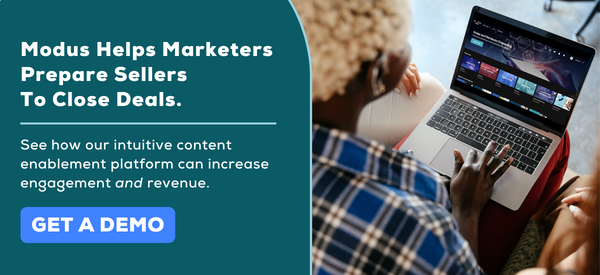You've probably heard it before. "Content is King!"
But did you know that line was from an essay Bill Gates wrote in 1996? The same year we saw the introduction of the scroll wheel mouse, Nintendo 64, and the PalmPilot. In his essay, Gates prognosticated:
"Content is where I expect much of the real money will be made...the broad opportunities for most companies involve supplying information or entertainment. No company is too small to participate."
Today, engaging content is one of the most important parts of an effective marketing strategy. But with the plethora of content being generated to engage customers, how do you ensure your content stands out and comes to life?
Unfortunately, creating engaging content is a challenging endeavor. In fact, studies show it's a top B2B marketing challenge—with 60% of marketers struggling to produce it (Content Marketing Institute).
Modern content enablement tools can alleviate some of this struggle because they're naturally more interactive and visual than information-loaded binders and wordy papers. But what else can you do to up the ante with your content? Here are five easy-to-implement ideas:
1 | Make a Great First Impression
How many times have you heard, “don’t judge a book by its' cover?” But a majority of the time, our first basis of judgment is exactly that.
This goes for first impressions of content enablement tools, too. First impressions are 94% design-related. A positive first impression can affect the way a user perceives your company or brand in future interactions. So, it's pretty damn important to make the right first impression!
Our take on creating a positive first impression:
- A powerful, hard-hitting image will grasp the prospect's attention from the get-go. If your opening page isn’t visually intriguing you’ve already run the risk of losing their interest.
- Readers need to know what they're looking at is relevant and useful. Branding makes things look professional, and boosts validity. Logos should be up-to-date, and color schemes should fit the company and the presentation.
- Ensure the content you are sharing actually adds value, and delivers something your prospect needs—but can't get on their own. This immediately helps to establish you as someone who understands their unique business problems, and is in the game to solve...for them!
2 | Understand What's Moving the Needle
So, how do you make the content you deliver efficient and useful? The most effective marketing strategies provide customers with a positive experience that leaves them feeling that you truly care about helping their business thrive. This positive experience is grounded in the content you present—your content enablement platform is only as strong as your weakest piece of content.
As mentioned earlier, word-heavy documents may be full of information, but the prospect only wants to know the most important takeaways. Two-thirds of B2B buyers (66%) strongly agree that B2B vendors should stop overloading materials with copy/small print to improve the value of their content.
Every prospect is different, so it's critical that content is targeted to your audience. For example, some customers will be more analytical and intrigued by holistic statistics and charts. Others might be more creative-minded and better digest videos and infographics. You want your content to reflect that in these ways:
- Make sure your content is emotionally connected to the audience. Know where your audience comes from, and tailor the pathos of your message to sell your product.
- Provide personal examples to deepen their connection with your product. This connection further establishes it as something that they not only want, but something that they need.
- Demonstrate industry knowledge using examples and statistics. Keep in mind that not everyone is familiar with what you do, and using heavy industry-specific lingo can be overwhelming. Simplify where it is necessary.
3 | Say Yes 👍 to Visual 👀 Content
When people hear information, they're likely to only remember 10% of it three days later. BUT, if a relevant image is paired with that same information, retention jumps to 65%!
The hype around interactive content is real. In today's environment, PDFs, spec sheets and linear sales presentations aren't enough to keep your prospects engaged. Technology has changed the game for content creators, allowing anyone to create rich, interactive content experiences—without outside agencies, software engineers, or coding skills. That's why it's critical to meet your buyers' modern expectations with something like a digital sales room to effectively share content and truly engage your buyers.
Using interactive elements like pictures, videos, and virtual product tours may be the key to keeping your brand and solution at the top of your prospect’s mind.
4 | Become a Better Storyteller
Just because people don’t like information-heavy documents doesn’t mean they don’t like to read. It really all comes down to presentation. Turning your content into a story—and presenting it in an interactive way— can inspire and compel prospects in ways that a regular sales pitch never could.
According to Kuno Creative, there are 4 simple components of creating a story:
-
Set the stage - Highlight how your content is relevant to your prospect.
-
Introduce Conflict - Show how the product or service you are trying to sell is going to directly help the business problem at hand.
-
Achieve Resolution - Use specific examples of how your product or service helped a company with a similar problem. Use success stories that highlight how your product has solved business challenges for other customers.
-
Conclude - Bring that story home. You've told a great tale, now provide some direction.
5 | Call Them To Action
The conclusion to your story is the call to action. After a compelling presentation, prospects may be ready to make the next move forward. Your CTA needs to be strategically tailored in a way that is relevant to the prospect's and your business objectives. Effective CTAs include:
-
An opportunity for the prospect to try your product. (Without being forced to commit to it right away!) This often comes in the form of a free trial or even an interactive demo.
-
A next step. In other words, tell them what they need to do when they are done digesting your content.
-
Clear direction. That you want them to respond to right away. They might forget or never return if they take more time to think about it.
Every piece of content has the potential to engage and move a sale forward. It all comes down to knowing your audience, understanding what motivates them, and crafting a relevant story. Here's to your future content success!



